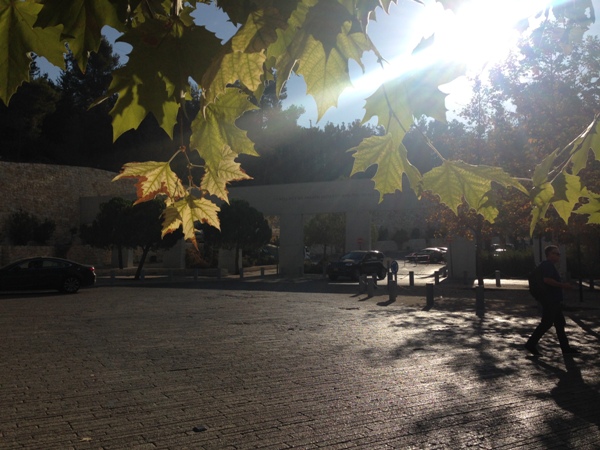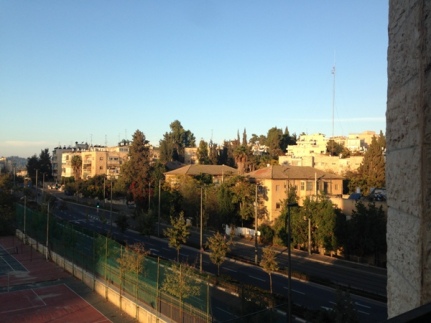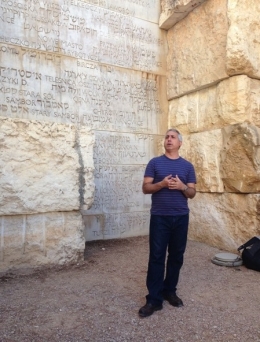
Yad Vashem – Memorial of names – ‘I will put my breath into you, and you shall live again, and I will set you upon on your own soil…’ (Ezekiel 37:14)
Morning brings with it new introductions, the first being the cityscape outside of our hotel window, which was in darkness when we arrived yesterday evening. An earlier decision to go for a morning swim in the pool was postponed (due to the towel situation) but breakfast was delicious and plentiful before we boarded the minibus to be taken to Yad Vashem where the seminars are to take place.

Daylight brings a clearer view
Firstly an introduction to each other, including our host Yiftach Meiri, who is the Lead at Yad Vashem for groups from Denmark, Finland, Ireland, Norway, Sweden, and the United Kingdom, when we share a little bit about ourselves and why we have chosen to come on this series of seminars. An eclectic mixture of lay leaders, church ministers, priests, ordinands, church educators, cathedral deans and even a bishop, drawn from various church denominations as widespread as Edinburgh, Northern Ireland and deepest darkest Somerset.
Then the real learning begins with our first seminar – An Introduction to Judaism (On One Foot) given by Ophir Yarden. The origins of this unusual expression ‘on one foot’ actually provides a very simple but effective answer. The story goes that a gentile wishing to convert to Judaism said he would do so only if a rabbi could teach him the entire Torah while he, the prospective candidate, stood on one foot. Most rabbi’s thought this was a ridiculous request, but Hillel, one of the most famous rabbis who lived at the end of the 1st Century BC and who is associated with developing the Mishnah and Talmud, gave this response:
What is hateful to you, do not do to your neighbour. That is the whole Torah;
the rest is the explanation of this–go and study it!”
Remind you of another famous saying?

The view over one of the valleys at Yad Vashem toward an Ultra Orthodox Jew community where most of the men will spend up to 14 hours a day studying while the women go out to work
But of course there is more to Judaism, some of which is not so simple to explain and it has as many different hues and forms as most religious groups, from liberal Judaism to traditional Judaism; Zionist to Hasidic Judaism (colloquially known as the Men in Black). Still a useful exercise to get us started.
The afternoon brought us an introduction to teaching about the Holocaust and the first thing we learnt is that the preferred term is Shoah a word that appears in the bible several times, meaning ‘destruction’. This is not to deny the other victims of the genocide: the Roma people; homosexuals; the physically and mentally disabled; the Poles and other Slavic peoples, but it makes it more personal to the fate of the majority who were Jewish.
The Shoah as a story of mankind. It was done by humans and suffered by humans
Our lecturer Dr Noa Mkaton, spoke of the problems with telling history; the main concern being that as it was the Nazi’s intention to systematically destroy every single Jew the result would be that there would be no one to tell the story from any other angle other than the perpetrators. It became imperative therefore that ways were found to pass on the stories of not only the Jewish people but individual families histories as well. Hence Yad Vashem became a resource for the names and stories to be gathered together in one place. There were some six million stories to be gathered and work on this still continues today and for the foreseeable future.
But stories can be told not only in words but in pictures as well. Of the many photographs that we see of the holocaust or Shoah they are almost certainly of humiliated, browbeaten, tortured people; either political propaganda or physical evidence of murder and abuse. Yet, there are narratives to be told from photographs taken in happier times that can be more effective in telling what has happened and give us insights into Jewish identities both before, during and after.

A Childhood Portrait
The ‘before’ picture is of a two children, dressed in their best clothes and probably taken by their proud parents to have their portraits done in a studio, creating a physical memento that could no doubt be looked at in later years to smile at the poses and the outfits, but nonetheless a pinpoint of what life was like at that moment. Would you be able to tell that the children were Jewish? Does it matter that you can’t tell?
Who knows if a picture of these children exists at the time of their incarceration in the ghetto or one of the concentration camps – most likely they were not even there long enough to ‘pose’ for a photograph, but perished almost immediately in one of the ‘gas showers’.
For one survivor of the holocaust a picture, such as this, was the only thing he had left, although he could never speak about had happened, his story is ‘articulated so clearly by the words he wrote on the back of photograph in 1945 after he was ‘liberated’. He simply wrote ‘Paper Children’.

Yiftach explains the significance of the inscriptions in the Valley of the Communities
The day finished with a visit to ‘The Valley of the Communities’ This is a massive 2.5 acre monument literally dug out of natural bedrock. Over 5000 names of communities are engraved on the stone walls , each name recalling a Jewish community which existed for hundreds of years. Today, in most cases, nothing remains but the name.
Its symbolic connection to Ezekiel’s valley of dry bones is emphasised with no deliberate planting at ground level, but some growth at the top of the stones to represent new risen life; but its greatest impact is in the space in between – a deliberate void.

A full and interesting day, laying out the groundwork for our seminars over the coming days – but maybe this evening there should be an introduction to the nightlife of the city as well!
Thank you Linda for such an enlightening commentary of your day.